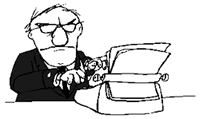|
|
 
Unit
2 - Theatre History
Module
1: Understanding Historical Context
Lesson
4 - Realism & Contemporary Theatre
Introduction:
The
purpose of these activities is to promote student discussion
of modern theatre, from Ibsen to Tremblay. Students use discussion,
reading, and research to explore the many directions theatre
has taken.
Resource:
(pdf) Background
notes for theatre history unit
 |
This
icon indicates an advanced print resource you can refer
to for more in depth research information. It has been provided
courtesy of Dr. Moira Day, University of Saskatchewan, Theatre
Department. |
Activities:
Activity
1 - Reading Historical Background Notes:
You should read the notes and save a copy for your binder
by printing a paper copy.
-
the
19th century began a period characterized by naturalism and
realism.
-
playwrights
such as Ibsen, Chekhov, Shaw, and Strindberg led the way in
this new type of theatre which reflected a language and style
more natural to real life - excess and melodrama play lesser
role.
-
actors
began to use the "fourth wall", imagining a wall
where the audience sits, keeping the belief entirely in the
scene and not speaking to the audience.
-
Stanislavski
(see Unit 3, Acting Technique for more information) developed
Method Acting for the new theatre. The "Method"
requires actors to approach their work from a personal response,
identifying the psychological and emotional life of a character.
-
Playwrights
were concerned with social and economical problems of the
day - rather than provide an escape, theatre engaged in discussion
and illumination.
-
Playwrights
gave: characters
specific stage directions; characters are individuals - not
stereotypes, heroes and heroines;
detail to physical appearance of character.
-
Theatre
repertoire also expanded to include burlesque, music halls
and lyric opera. The Industrial Revolution brought more people
into the city and there was a call for more popular "vulgar"
entertainment.
-
in
the early part of the 20th century, an artistic revolt begins
against the commercial stage. Similarly, artists, musicians
and dancers are experimenting further with the concept of
art.
-
two
directions were: 1) increasingly graphic and more sophisticated
forms of realism; and 2) move into symbolism and non-illusionistic
forms of theatre. Both involve experimentation in aesthetic
and technical aspects of the theatre.
-
increasing
use of experimental sound, lighting, costume and innovation
in design of sets.
-
theatre
played many roles: sometimes meant to capture the inner landscape
of the mind and the collective unconscious; or to move people
to social action; or to re-examine older, alternative traditions
in the East; to explore national identity; or to provide drama
in education.

Activity
2 - Jigsaw Activity
You
and your classmates form 6 home groups. The teacher should break
you into expert groups. Each expert group must have at least one
member from each of the home groups. Then your teacher will assign
each expert group one playwright and his play (refer to the list
below, or other plays available to you.)
Michelle
Tremblay
"For the Pleasure of Seeing Her Again" |
Oscar
Wilde
"The Importance of Being Earnest" |
Samuel
Beckett
"Waiting for Godot" |
Arthur
Miller
"The Death of a Salesman" |
Connie
Gault
"Soft Eclipse"
(Saskatchewan playwright)
|
Eugene
Ionesco
"The Bald Soprano" |
-
You
should read the play with your expert group and discuss it.
Set specific focus areas such as writing style, topic, theme,
focus, contrast, symbol and set style.
-
The
groups must find out some information about the playwright
by using an advanced search on-line (biographical, other plays
of note, influence on theatre).
-
As
an expert group, you should decide how one scene in your play
should be presented (set, lighting, music, costume).
-
The
expert groups break up, and the new experts join their home
groups. Once in the home groups, you present the information
you have learned to the group, and everyone writes it down.
The information then becomes notes for a possible open-book
test.
Evaluation:
The teacher may evaluate individual participation in
jigsaw exercise and construct an open-book test on the lesson
material.
Next
Lesson /Previous Lesson
|
|









